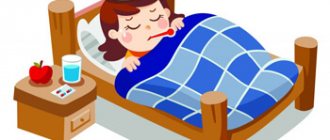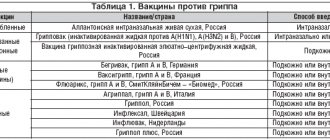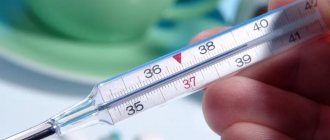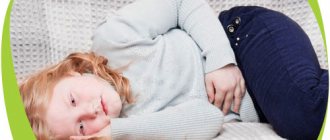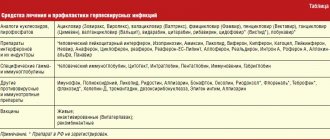In the summer, when most parents try to send their children on vacation to warmer climes, the risk of getting an intestinal infection increases significantly. It is very common to hear at a pediatric appointment a request to make a list of medications that may be useful if the child gets sick while on vacation away from home, and of course, medications for the treatment of intestinal disorders are at the top of this list.
In this article, we decided to compose a small instruction for parents with children going on vacation, as they used to say: “at the request of the workers.”
Causes
There are 2 causes of intestinal infection in people, and both of them are a consequence of the penetration of harmful microorganisms into the body. In the first case, the disease is caused by intestinal viruses. There are about 10 groups of them. The most famous and common among them are enterovirus, adenovirus and rotavirus intestinal infections. Infants are very susceptible to rotavirus, or as it is popularly called “intestinal flu”. The second causative agent of intestinal infection in young children is bacteria. Bacterial infection is much better known under the names: coli infection; dysbacteriosis; salmonellosis and others. Infection with intestinal infections occurs through the fecal-oral route, that is, through the mouth. And the mediators can be dirty hands, unwashed fruits, non-compliance with hygiene standards. You can't keep an eye on your child here. In general, children under the age of seven are most susceptible to intestinal infections. After all, children's immunity to pathogenic bacteria and viruses is very weak compared to adults. This is especially true for newborns.
Description of the disease
Intestinal infection refers to diseases of the gastrointestinal tract caused by bacterial, viral or fungal agents.
The most common pathogens are: enteroviruses, rotaviruses, salmonella, staphylococcus, dysentery bacillus, etc. Intestinal tract infections are widespread in childhood. In terms of incidence, they are second only to respiratory diseases. Infection, as a rule, occurs due to non-compliance by the child and his parents with the rules of personal hygiene, sharing toys and other household items with infected people, and eating unwashed vegetables and fruits. The disease can be identified by impaired bowel movements, nausea, vomiting, a sharp decrease in appetite and an increase in body temperature.
If you suspect that a child has an intestinal infection, you should immediately seek advice from a gastroenterologist. Lack of treatment can provoke the development of serious complications: septic condition, shock due to vascular paralysis due to bacterial intoxication, acute kidney failure, heart failure, etc.
Symptoms
The first signs of rotavirus can appear within 24 hours after infection, but more often they appear 3-5 days after the virus enters the body. The symptoms of the disease are acute and obvious: the temperature rises sharply and strongly (up to 38-390); vomiting occurs several times a day (up to 3-6); the general condition of the child is lethargic, apathetic; frequent watery diarrhea begins with a pronounced light yellow tint and an unpleasant sour odor; redness of the mucous membranes of the eyes and throat occurs. Along with the manifestations of the disease described when rotavirus occurs, in the case of enterovirus infection the following may be observed: fever, convulsions, muscle and head pain. Signs of a bacterial infection are similar to the manifestations of a viral infection - these are the same elevated temperature, but up to 37-380C, vomiting (with viral infections it is always present, and with bacterial infections - in half the cases), diarrhea (if watery yellow diarrhea is observed with viral infections, sometimes with foam, then with a bacterial infection it necessarily contains inclusions of mucus, has a greenish tint, sometimes small blood clots are found in the stool - in an advanced form.
Intestinal infection in children
Dysentery in children
After a short incubation period (1-7 days), the temperature rises sharply (up to 39-40° C), weakness and fatigue increase, appetite decreases, and vomiting is possible.
Against the background of fever, there is a headache, chills, and sometimes delirium, convulsions, and loss of consciousness. Intestinal infection in children is accompanied by cramping abdominal pain localized in the left iliac region, symptoms of distal colitis (pain and spasm of the sigmoid colon, tenesmus with rectal prolapse), symptoms of sphincteritis. The frequency of bowel movements can vary from 4-6 to 15-20 times per day. With dysentery, the stool is liquid, containing impurities of cloudy mucus and blood. In severe forms of dysentery, hemorrhagic syndrome may develop, including intestinal bleeding. In young children with intestinal infection, general intoxication prevails over colitis syndrome; disturbances in hemodynamics, electrolyte and protein metabolism occur more often. The most common intestinal infection in children is caused by Shigella Zona; heavier - Shigella Flexner and Grigoriez-Shig.
Salmonellosis in children
Most often (in 90% of cases) the gastrointestinal form of salmonellosis develops, occurring as gastritis, gastroenteritis, gastroenterocolitis. Characterized by subacute onset, febrile fever, adynamia, vomiting, hepatosplenomegaly. Stool with salmonellosis is liquid, copious, fecal, the color of “swamp mud”, with admixtures of mucus and blood. Typically, this form of intestinal infection ends in recovery, but in infants it can be fatal due to severe intestinal toxicosis.
Influenza-like (respiratory) form of intestinal infection occurs in 4-5% of children. In this form, Salmonella is detected in cultured material from the throat. Its course is characterized by febrile temperature, headache, arthralgia and myalgia, symptoms of rhinitis, pharyngitis, conjunctivitis. From the cardiovascular system, tachycardia and arterial hypotension are noted.
The typhus-like form of salmonellosis in children accounts for 2% of clinical cases. It occurs with a long period of fever (up to 3-4 weeks), severe intoxication, and dysfunction of the cardiovascular system (tachycardia, bradycardia).
The septic form of intestinal infection usually develops in children in the first months of life who have an unfavorable premorbid background. It accounts for about 2-3% of cases of salmonellosis in children. The disease is extremely severe, accompanied by septicemia or septicopyemia, disruption of all types of metabolism, and the development of severe complications (pneumonia, parenchymal hepatitis, otoanthritis, meningitis, osteomyelitis).
Escherichiosis in children
This group of intestinal infections in children is extremely extensive and includes coli infections caused by enteropathogenic, enterotoxigenic, enteroinvasive, and enterohemorrhagic Escherichia.
Intestinal infection in children caused by Escherichia, occurs with low-grade or febrile temperature, weakness, lethargy, decreased appetite, persistent vomiting or regurgitation, flatulence. Characterized by watery diarrhea (copious, splashing yellow stool mixed with mucus), quickly leading to dehydration and the development of exicosis. In Escherichiosis, caused by enterohemorrhagic Escherichia, the diarrhea is bloody.
Due to dehydration, the child develops dry skin and mucous membranes, tissue turgor and elasticity decreases, the large fontanel and eyeballs sink, and diuresis decreases such as oliguria or anuria.
Rotavirus infection in children
It usually occurs as acute gastroenteritis or enteritis. The incubation period lasts on average 1-3 days. All symptoms of intestinal infection in children develop within one day, while damage to the gastrointestinal tract is combined with catarrhal symptoms.
Respiratory syndrome is characterized by hyperemia of the pharynx, rhinitis, sore throat, and coughing. Simultaneously with damage to the nasopharynx, signs of gastroenteritis develop: loose (watery, foamy) stools with a frequency of bowel movements from 4-5 to 15 times a day, vomiting, temperature reaction, general intoxication. The duration of intestinal infection in children is 4-7 days.
Staphylococcal intestinal infection in children
A distinction is made between primary staphylococcal intestinal infection in children, associated with eating food contaminated with staphylococcus, and secondary, caused by the spread of the pathogen from other foci.
The course of intestinal infection in children is characterized by severe exicosis and toxicosis, vomiting, and increased bowel movements up to 10-15 times a day. The stool is liquid, watery, greenish in color, with a small admixture of mucus. With secondary staphylococcal infection in children, intestinal symptoms develop against the background of a leading disease: purulent otitis media, pneumonia, staphyloderma, tonsillitis, etc. In this case, the disease can take a long wave-like course.
Diagnostics
Bacteriological cultures of stool and, in some cases, vomit. This is the leading diagnostic method. Determines which microbe is causing the intestinal infection. To analyze the stool, a smear is taken from the child’s anus (it is also called a “VD smear” or “intestinal group smear”). The resulting material is sown on special nutrient media. After a few days (usually 5-7 days), colonies of bacteria grow, which can be examined under a microscope and tested using various methods. Unfortunately, it is not always possible to detect the pathogen. Blood tests to determine the increase in antibody titer to any pathogen. Determine the reaction of the immune system to a suspected infection. If there is an increase in antibodies to a specific pathogen, then we can say with confidence that the person is sick (or has been sick). This method is rarely used in practice. Express diagnostics: enzyme-linked immunosorbent assay (ELISA) and other laboratory tests. They are mainly used in hospital settings. Scatological analysis of stool. In it you can see the degree of digestion of food, blood, mucus and protozoa (amoeba and lamblia).
general information
The group of intestinal infections characteristic of childhood includes diseases of a bacterial and viral nature, accompanied by signs of general intoxication of the body and dehydration. In terms of frequency of occurrence, intestinal infections are in 2nd place after ARVI and influenza. The adult body is less susceptible to infectious pathogens that cause digestive disorders. Intestinal infections are most severe in infants. In this case, not only dehydration is observed, but also symptoms such as dysbiosis, a sharp decrease in body weight, deficiency of pancreatic enzymes and decreased immune defense.
Treatment
The biggest mistake parents make is the desire to stop seemingly unwanted manifestations of the disease. But in the first hours this is strictly forbidden, because vomiting and diarrhea are a protective reaction of the body, which is trying to cleanse itself of toxins. Stopping cleaning will lead to even greater intoxication. It is important to constantly replenish the loss of fluid and mineral salts (potassium, sodium, calcium). You should ensure that your child drinks plenty of fluids. It is necessary to drink with special solutions. No juices or dairy! For acute intestinal infections, a saline solution is used: 1 teaspoon of table salt, 4 teaspoons of sugar and 1.5 teaspoons of baking soda per liter of water. You need to give your child 2-3 teaspoons of water every 3-5 minutes. If a child vomits, then it is necessary to drink in small portions so as not to provoke repeated attacks. It is best to give the child a warm drink (at body temperature): in this case, the absorption of liquid from the intestinal walls into the blood will occur as quickly as possible, which is now extremely important. Feeding a child who has an intestinal infection is extremely undesirable and one might even say that it is impossible. Hunger is the second cure in such a situation. The gastrointestinal tract is now affected, it has no time to digest food. When the child feels better and he still demands to eat (only in this case!), stick to the diet: light rice soup, oatmeal or rice porridge, low-fat cottage cheese or kefir, mashed potatoes with water. You can also make a puree from baked apples, steamed carrots, pumpkin, zucchini, grated apples and bananas. It is forbidden to give your child foods that cause gas or contain coarse fiber. And no sweets, fatty, spicy, salty or smoked foods. Portions should be small: it is better to feed the child often, but in fractions. Monitor your child's hygiene very carefully. Be especially careful about hand washing after using the toilet and before eating. Only a doctor can judge the advisability of prescribing antibiotics and other medications. Therefore, you should not self-medicate.
